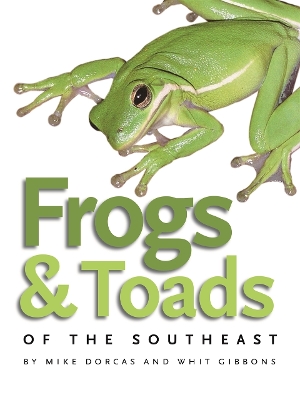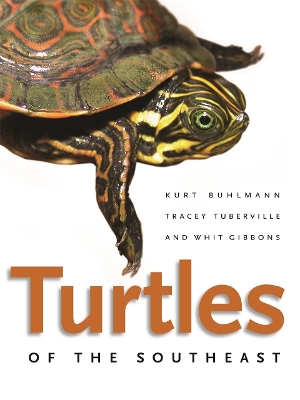Wormsloe Foundation Nature Book
3 total works
With more than forty native and introduced species of frogs and toads occurring in the southeastern United States, the region represents the heart of frog and toad diversity in the country. Renowned herpetologists Mike Dorcas and Whit Gibbons provide us with the most comprehensive and authoritative, yet accessible and fun-to-read, guide to these sometimes wet, sometimes warty wonders of nature.
Dorcas and Gibbons enumerate the distinguishing characteristics of frogs and toads, including how they are different from other amphibians and the differences between a frog and a toad. Also discussed are the morphology of frogs and toads, the main groups to be found in the Southeast, and their habitats. Individual species accounts contain a physical description of the species plus information about distribution and habitat, behavior and activity, food and feeding, predators and defense, calls and vocalizations, reproduction and description of eggs and tadpoles, and conservation. Accompanying each account are photographs illustrating typical adults and variations and distribution maps for the Southeast and the United States.
Given the recent worldwide decline in amphibian populations and increasing scientific and popular concern for what these declines mean for all other organisms, Frogs and Toads of the Southeast will appeal to people of all ages and levels of knowledge interested in natural history and conservation. The guide will help foster the growing interest in frogs and toads as well as cultivate a desire to protect and conserve these fascinating amphibians and their habitats.
Features:Conservation-oriented approachApproximately 250 color photographsApproximately 45 distribution mapsClear description and photographs of each species in both tadpole and adult stagesChapters on identification, vocalizations, reproduction, global diversity (including remarkable species such as the gastric brooding frog, poison dart frogs, and saltwater frogs), and introduced speciesA selection of frog and toad vocalizations at www.ugapress.org/FrogsAndToads
Fifty-three kinds of snakes can be found in the Southeast, almost half of all species native to North America. Filled with more than 300 color photographs and written by two renowned herpetologists, this new edition is the most comprehensive authoritative guide to the snakes of the region.
At the heart of the book are its heavily illustrated, fact-filled descriptions of each snake species. Also included is a wealth of general information about the importance of snake conservation and the biology, diversity, habitats, and ecology of snakes. Find useful information about the interactions of humans and snakes: species that are likely to be found near houses, snakes as pets, what to do in case of a snakebite, and more.
The revised edition of Snakes of the Southeast includes new photos, the latest research findings, new species discoveries, and the most current geographic range maps. Clearly written, cleanly designed, and fun to use, this guide promotes a better understanding of the conservation of this fascinating but often maligned group of animals.
Features:Conservation-oriented approach
Over 300 color photographs, including many new images for this edition
New distribution maps for 53 species of snakes
New accounts of invasive snakes of the Southeast
Clear descriptions of each species, including differences in the appearance of young and mature snakes
Size charts, key identifiers (scales, body shape, patterns, and color), descriptions of habitat, behavior and activity, food and feeding, reproduction, predators and defense, and conservation
Turtles of the Southeast
by Kurt Buhlmann, Tracey Tuberville, and Whit Gibbons
Seventy-five percent of the turtle species in the United States can be found in the Southeast. In fact, the region is second only to parts of Asia in its number of native turtles. Filled with more than two hundred color photographs and written with a special focus on conservation, this guide covers forty-five species of this nonthreatening, ancient lineage of long-lived reptiles.
Heavily illustrated, fact-filled descriptions of each species and its habitat comprise the heart of the book. Species accounts cover such information as descriptions of adults and hatchlings; key identifiers including size, distinctive characters and markings; land, river, pond, and wetland habitats; behaviors and activities; food and diet; reproduction; predators and defense; and conservation issues.
Also included is a wealth of general information about the importance of turtle conservation and the biology, diversity, and life history of turtles. Discussed are distinguishing turtle characteristics; differences among turtles, tortoises, and terrapins; shell structure and architecture; reproduction and longevity; turtle predators and defense mechanisms; and turtle activities such as basking, hibernation, aestivation, and seasonal movement. Useful information about the interactions of humans and turtles is also covered: species that are likely to be commonly encountered, turtles as pets, and more.
Clearly written, cleanly designed, and fun to use, the guide will promote a better understanding of the habitat needs of, and environmental challenges to, this fascinating group of animals.
Features:In-depth descriptions of the forty-two native speciesConservation-oriented approachMore than two hundred color photographsNearly forty distribution mapsClear descriptions of each species, including differences in the appearance of young and mature turtles“Did You Know?” sidebars of interesting turtle factsSize charts; key identifiers; and information about habitat, behavior and activity, food and feeding, reproduction, predators and defense, and conservation


